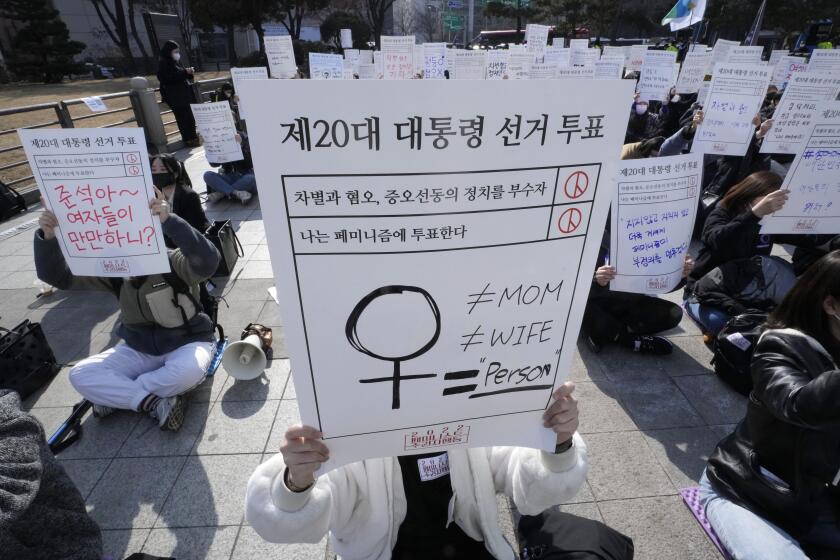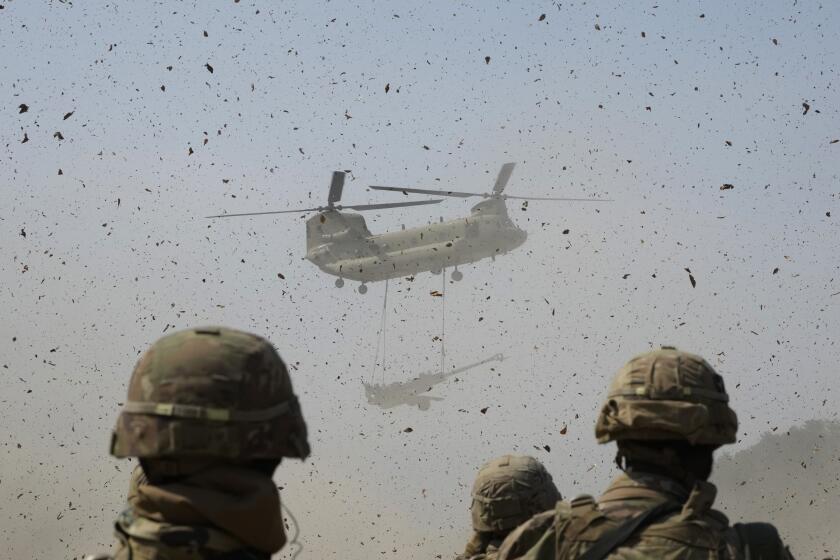Palestinians Need a Gandhi, Not a New Arafat
- Share via
One of the last foreigners to visit Yasser Arafat before he fell ill was Arun Gandhi, grandson of Indian leader Mohandas K. Gandhi. He traveled to Arafat’s compound in Ramallah with a simple message: Put down the gun and adopt Gandhi’s way of nonviolent resistance.
By that time, it was a bit late to change Arafat’s tactics. The Palestinian leader’s strategy, all through his life and in his final days in Ramallah as well, had been one of victory at all costs and by any means. But my advice to the next Palestinian leader, whoever that may be, would be this: Look to Gandhi, not Arafat, as your role model.
This doesn’t mean capitulation, but rather the opposite. Gandhi’s strategy of satyagraha -- literally “soul force” -- isn’t some granola idea conjured up in the halls of UC Berkeley, nor should it be confused with weak-kneed pacifism. It is a potent weapon -- one that helped topple the British empire and that could prove far more effective in Palestine than the bullets and bombs that have characterized the 4-year-old intifada so far. That strategy, which has killed hundreds of Israelis and helped cause the death of thousands of Palestinians, has gotten the Palestinians precisely nowhere. It is time for new thinking, even if that means dusting off some old ideas.
One hundred years after Gandhi first experimented with nonviolent tactics in South Africa, his approach to conflict resolution remains widely misunderstood. A wily lawyer who understood the nature of power and how to use it, Gandhi was no pacifist. He was a fighter. His aim, however, was to transform his opponents, not merely defeat them.
Gandhi’s nonviolent tactics won’t work everywhere. They couldn’t move a Stalin or a Hitler -- or a Saddam Hussein. But Israel, like Britain in Gandhi’s time, is a nation that views itself as morally accountable and is therefore a perfect target for nonviolent resistance.
Already, there are inklings of a nascent nonviolent movement among some Palestinians. The prisoners who recently embarked on a hunger strike at an Israeli prison borrowed a page from Gandhi’s playbook, knowingly or not. So have those who advocate a boycott of Israeli goods and peaceful protests against the wall that Israel is erecting along the West Bank.
But these actions haven’t gone far enough, and too often they have been overshadowed by the suicide bombings and other violent acts carried out by Hamas, Islamic Jihad and other factions.
These groups argue that the ends (a free Palestine) justify the means (violence). But Gandhi didn’t see it this way. He made no distinction between means and ends. For him, they were one and the same. He once said no man “takes another down a pit without descending into it himself.” If Gandhi were alive today, he would no doubt tell Arafat’s successor that freedom won through violence is no freedom at all.
By adopting nonviolent tactics, the Palestinians would have plenty of company. Martin Luther King Jr. borrowed heavily from Gandhi during the U.S. civil rights movement. The Philippines’ “people power” revolution, Solidarity in Poland and, more recently, the peaceful demonstrations in Serbia in 2000 are all successful examples of nonviolent resistance.
There are examples from the Muslim world as well. In the 1920s and ‘30s Abdul Ghaffar Khan used nonviolent methods to resist British occupation along what is now the Pakistani-Afghan border. More recently, Iraq’s Grand Ayatollah Ali Sistani used his moral standing to peacefully end the standoff at the Imam Ali shrine in Najaf. Why can’t the Palestinians be next?
True, Hamas and Islamic Jihad are not likely to adopt nonviolent tactics, at least not immediately, and even mainstream Palestinians such as Eyad Sarraj, a leading psychiatrist in Gaza, worry that “nonviolent resistance would look like a form of surrender.”
Gandhi would counter that such resistance is a continuation of the struggle, only through different means. Pictures of unarmed Palestinians lying down before bulldozers about to raze their homes or marching up to the gates of Jewish settlements in the West Bank and Gaza -- again unarmed and completely peacefully -- would be powerful images that could do more to advance the Palestinian cause than 100 suicide bombings.
It wouldn’t be easy. In fact, nonviolence is in many ways more difficult to practice than violence. Many Palestinians might die in the process, perhaps in greater numbers than they are dying now. On this point, Gandhi was clear-eyed. He and his followers were willing to die for their cause, just like the Hamas suicide bombers. Unlike the Hamas bombers, they were not willing to kill for it -- under any circumstances.
After years of terrorism, the world would, understandably, cast a wary eye toward a new Palestinian leader espousing nonviolence. But once this nonviolent intifada, or what some Muslims are calling a “civil jihad,” took hold, it would enable the Palestinians to reclaim the moral high ground and garner international support. And surely Israel wouldn’t object to a shift away from violence.
The Israeli-Palestinian conflict is ripe for Gandhi-style civil disobedience. That’s a fact that Arafat was unable -- or unwilling -- to grasp. It is one that his successor would be wise to embrace.
More to Read
Sign up for Essential California
The most important California stories and recommendations in your inbox every morning.
You may occasionally receive promotional content from the Los Angeles Times.













